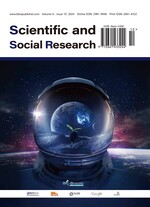Analyze the Cultural Efficacy of the Ancient Shipwreck Hailao Porcelain in the New Era from the Perspective of Culture
Abstract
The presence of Hailao porcelain in the world is widespread, with historical, economic, practical, artistic, and other functional attributes, so its comprehensive benefits cannot be underestimated. The development of modern science and technology, and the reasonable and effective development of Hailao porcelain in different times, are conducive to the development of China’s cultural construction. Because Hailao porcelain is different from the traditional ancient porcelain (handed down and unearthed), it is a new cultural research field. This marine wealth has great economic, cultural, and historical value, and plays an important role in the cultural construction and social development of the country in the new period. The cultural efficacy covered by the ancient shipwreck Hailao porcelain includes the functions of inheritance, cognition, education, communication, and so on, which is conducive to the current cultural development. People can use the new perspective and new concept of cultural and creative thinking to make these cultural relics “alive”, give play to the new cultural value, promote the economy of cultural relics and works of art, serve the spiritual and cultural life, and strengthen the cultural exchanges and cooperation between China and other countries in the world.
References
The National Maritime Museum of China, 2017, Exquisite “Hailao Porcelain”. Encyclopedic Exploration (Underwater World), 2017(7): 48–51.
Yang TY, 2021, Ming and Qing Trade Porcelain in Shipwrecks along the Southeast Coast of China and Southeast Asia. Museum, 2021(2): 84–95.
Wu CM, 2020, The Rise of Marine Globalization around China Sea from Shipwreck Archaeology. Journal of the Palace Museum, 2020(5): 43–70 + 110.
Yan HO, 2024, The Life Landscape of the Maritime Silk Road. Journal of the Palace Museum, 2024(5): 37–50.
Wei J, 2023, Review on the new Progress of Maritime Silk Road Archaeological Research. Journal of the Palace Museum, 2023(12): 4–23.
Xu NN, 2023, The Exploration of the Rise and Decline of the Maritime Silk Road from the Historical Change of Major Export Commodities. Journal of Shanxi Datong University (Social Science Edition), 37(4): 38–43.
Du W, 2023, Zheng He and his “Maritime Silk Road”. Biographical Literature, 2023(6): 8–66.
Qu YW, 2023, Xu Fu: the Pioneer of China’s Maritime Silk Road. Openings, 2023(8): 72–73.
Fu YL, 2024, Xi Jinping’s Important Expositions on Marine Economic Diplomacy: Scientific Connotation and Value Implication. Social Sciences in Hunan, 2024(2): 16–22.
Tu MQ, 2017, Thoughts on Cultural Exchange and Dissemination along the Fujian Maritime Silk Road. Fujian Forum (Humanities and Social Sciences Edition), 2017(10): 163–168.
Wang H, 2015, Ownership and Legal Protection of Underwater Cultural Heritage, thesis, Hainan University.
Li GQ, 2013, Protection of Ancient Shipwrecks from the Ocean. Chinese Cultural Heritage, 2013(4): 66–67.
Bao CL, 2014, Discovery and Protection of Shipwreck of Huaguang Reef I in Southern Song Dynasty. Popular Archaeology, 2014(1): 35–41.
Li YT, 2016, Overview of Symposium on Historical and Cultural Studies of China’s Maritime Silk Road. Trends of Chinese History Research, 2016(5): 69–70.
Cui XL, 2006, Crazy “Hailao Porcelain”. China Economic Weekly, 2006(24):14–21.

